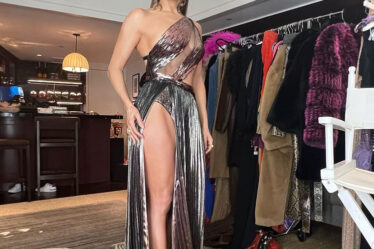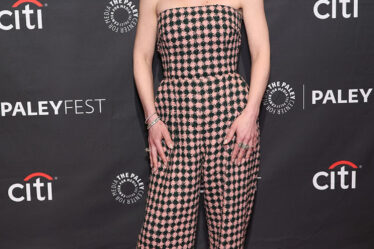
The May issue of British Vogue, titled Reframing Fashion, features 19 disabled people from fashion, sport, activism and the arts. Five of them are cover stars: the actor Selma Blair, who has multiple sclerosis; Sinéad Burke, a disability activist and consulting editor for the issue; the models Ellie Goldstein and Aaron Rose Philip; and the American Sign Language performer Justina Miles. Since Edward Enninful was appointed editor in 2017, Vogue has performed a 180-degree turn: from the pronounced, even defiant, homogeneity that was once its hallmark to a magazine at the frontier of what representation and diversity in fashion can look like.
Burke, meanwhile, came at fashion from the citizen side, writing a blog about the industry’s accessibility and
the visibility of disabled people within it. Over the past five years, it has turned into a global consultancy, Tilting the Lens.
Enninful and Burke’s mission with Reframing Fashion goes back to first principles and asks: what would a fashion shoot – or an image, or a magazine, or an industry, or society – look like if it were designed not for disabled people, but with them? “We have this notion that disability is invisible disabilities or physical disabilities,” says Burke. “The reality is, we live in an ageing society. We’ll all be disabled at some point in our lives. This is not about us. This is about all of us.”
Tell me your fashion origin stories. How did it all start?
Edward Enninful: I’ve been in the fashion press since I was 16 years old. I started as a model, but I knew that, as an industry, it was getting left behind. When I started here, so many people I knew said: “We don’t look at Vogue, we don’t see ourselves in it.” That was all I needed to hear. My work has always been about diversity in all its shapes; women of different sizes, ages, religions, socioeconomic backgrounds.
Sinéad Burke: I was training to be a primary school teacher and they asked us to create a blog. I created one about fashion. As someone with a physical disability and as a little person, I was hungry, always ravenous, for information. What does change look like? What do sustainability and accessibility look like, not as values, but as business initiatives? Through that, I got the opportunity to attend fashion shows. Disabled people have a skill set that is shaped by their experience. I have always been organised and articulate and tried to be considerate. Those are skills that I’ve had to harness for my own independence.
What inspired you to create Reframing Fashion?
Enninful: I met Sinéad when I started here, in 2018. We sat next to each other at the Burberry show and, from that minute, I just knew we were going to work together. I said: “I’m going to take your lead, because you’ve lived it. And you continue to change people’s perspectives on disability.”
Burke: I sat next to him, tugged on his sleeve and said: “Hi, I think what you’re doing at British Vogue is incredible, but have you ever thought about disability?” Knowing that, of course, based on his own lived experience, that was always going to be part of the conversation. So, in 2019, I was the first little person to be on the cover of any Vogue.
Why this issue now?
Burke: The pandemic was a mass disabling event. We all had a touchpoint to disability in a way we never had before. And yet, in the first cohort of deaths, six out of 10 people were disabled. We used language like “vulnerable” and “underlying conditions”, as if it was easier to accept those deaths. So, while our lived experience became much closer to disability, our awareness and empathy were unchallenged.
Where do you think representation of disability has got to?
Enninful: From my point of view, we are not doing enough in the fashion industry. I want to emphasise that I’m also learning. I have an invisible disability myself: I’ve had five retinal detachments, I’m partially blind and my hearing is less than 50% – I’m wearing hearing aids now. It’s never stopped me, but there are so many people with invisible disabilities who never talk about it, because it might hinder them. I’ve never had that fear. When I’m reading, it’s still difficult; when I’m doing interviews, I have to ask people to talk at a certain level. But these are things that are me, these are things that I’ve embraced. We always talk about diversity and inclusivity, but that also has to extend to our disabled brothers and sisters.
Burke: Representation and visibility are so important, but we need to acknowledge the systemic barriers that exist. It was lovely that we sat together in this building and said: here’s our ambition. But then we had to unpick the system. We had to make sure that the place itself was accessible. Does it have step-free access all the way through to the set, including the canteen and the bathrooms? Is there a quiet room on set for people who are neurodivergent, for people with requirements? You can imagine the information that came back was incredibly disappointing. When you look at representation as the only solution, you’re not acknowledging all the barriers there are to participation. It’s not just fashion – this is a microcosm of the wider world.
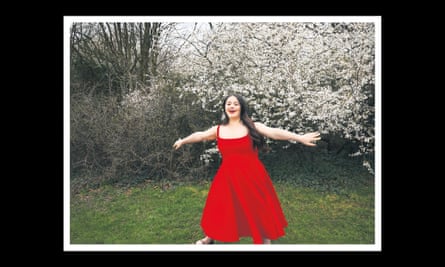
Do you see yourselves as being on a political mission?
Enninful: I would see it as just personal.
Burke: If we look at this portfolio of talent [in the forthcoming issue of Vogue], we have Dr Rosaleen McDonagh, who is a writer, and the Irish human rights and equality commissioner, and also an Irish Traveller. Is it political to have her in the issue, or is it just deeply personal, to ensure she has the pedestal and the platform she deserves? I think about Christine Sun Kim, the Asian American deaf artist. This is the value of having a lived experience in the room where decisions are made. It is about bringing in the humanity, creating an explicit invitation to people and saying: “You belong.”
Enninful: It’s an empathy question. I believe that, in whatever we do, we have to have empathy.
This industry is perceived as forbidding, harsh and judgmental. Have you experienced any of that?
Burke: Historically, there was a very specific definition as to what we defined and described as beautiful. In any industry, if you’re asking questions about or advocating for a change of that norm, you are often met with friction, uncertainty, nervousness. From the beginning, I was hoping to create change for far more than me. Particularly since the pandemic, I’ve really started to ask the question: in terms of the part that I’ve played within the fashion system, did it become more accessible? Or did it become more accessible for me? Because that’s not a broad enough definition of success.
Enninful: This is an industry that we both know very well. I’ve navigated it. I’m not scared. I’m very vocal. It’s up to us to change it. Vogue changed with the times; it had to. The brilliant thing is, it’s now a whole industry having these conversations. And we’re very proud of that.
Burke: What’s important about fashion is, wherever you participate in it, at whatever price point, the reality is we all have to participate in the fashion industry, because we all have to wear clothes. So, you may not have any interest in the most expensive streets in London, but the reality is, what happens in those rooms shapes what we have access to.
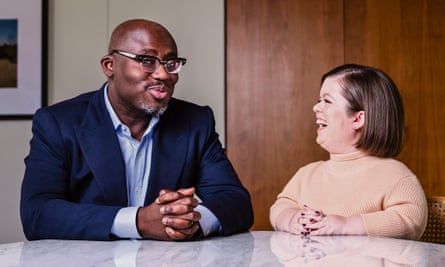
What has it been like dealing with the corporate world as an accessibility consultant?
Burke: It can be incredibly difficult. You’re sitting with somebody, saying: “This is an opportunity.” And somebody says: “We’re just not going to do it, because it’s too expensive.” Or because there’s a recession. Or “we don’t have time”. And when you are a member of that community and have that lived experience, you can’t help but feel like the refusal to participate is deeply personal. But I just choose differently the people I work with. The reality is, I will not convince everyone.
Do you ever think exclusivity is in the DNA of the industry?
Burke: I fundamentally believe that disability and accessibility are at the core of fashion’s DNA. Because where this industry started was made-to-measure. We have moved to something that is much more streamlined, much more cyclical. If we were to reflect on where this industry began, it was about customisation. It was, of course, veiled in wealth – and, in many instances, still is. But in terms of the history of this industry, it began designing for bodies, not designing for a mass market that the body then had to fit.
There is a seasonal logic to the industry. This leads people to think that, whenever there is a surge of representation, it will be short-lived, whether that’s plus-size models, or racial diversity; it will happen, then drop out of fashion.
Enninful: That’s why I always said, when I started at Vogue, you don’t just do a special issue and move on. We need representation in every single issue. And we’ve been able to do that – not perfectly, but we have done it.
Burke: Last season, there was some really challenging data around the lack of representation of fat and plus-size models, how it had decreased from previous seasons. Two weeks later, British Vogue had three supermodels who were plus-size. This is not a moment. But it goes back to the idea that representation has to be more than covers. It has to be inclusivity at every strata of the industry where decisions are made.
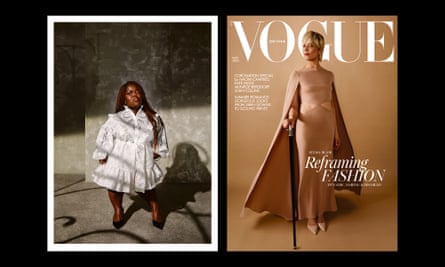
When you’re making editorial decisions about representation, where do you stand on invisible disability?
Enninful: Even before we did this issue, someone said we should do an issue on invisible disability and I said: there is no way we’re doing that. For me, you have to deal with both.
Burke: It’s about a broader intersectionality – can you imagine, in this issue, if we’d said we were going to have one definition of disability? Maybe Aaron Rose Philip, who is a black transgender disabled woman, wouldn’t be part of that. Our identities weave and overlap, we are not just one thing, and by not having a cacophony of voices in the room we further create a path where the most excluded continue to be excluded.
There are evolutions of diversity and inclusion in which fashion has led the way, and others in which it has lagged behind. How do you account for that?
Burke: Often, the people who have gravitated to this industry are people who felt excluded, people who wanted to discover who they were, people who came out as queer …
Enninful: People who’ve been othered.
Burke: And clothes were this tool, this armour they could put on; whether it’s a beautiful navy suit or a bell skirt, fashion gave them – and gave me, specifically – a vocabulary.
Enninful: And me.
Burke: So, we understood the language – and maybe LGBT people in particular felt seen and it felt like a safe place.
Enninful: We always think of fashion as where the misfits gather. We were all alienated one way or another and the industry welcomed us.
Burke: Clothes and beauty were ways in which people worked out who they were.
Enninful: I have always found it a very welcoming industry. I was a very shy, religious kid.
Burke: And look at you now.
Historically it has also been racist, right?
Enninful: Oh yeah. In the 1990s, they used to say things like: “Non-white models don’t sell covers.” And it was OK to say that. And I used to go: “Here’s another one. Here’s another one.” You continuously have to fight. You continuously have to show another way. It’s a complex industry.
Burke: What’s important about this issue is that, whether or not people pick it up, very few people in the world don’t know what Vogue is. And there are five disabled people on the cover of Vogue, being daring, dynamic – and disabled.
The May issue of British Vogue is available on newsstands and via digital download


